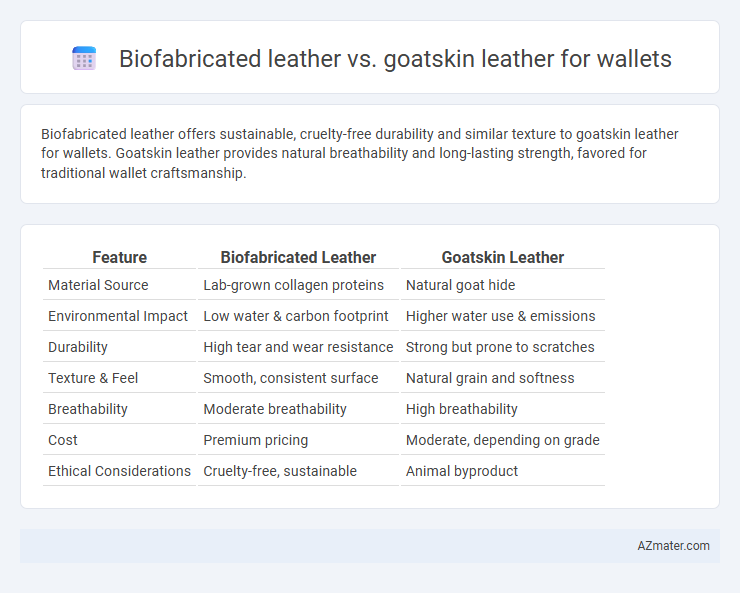Biofabricated leather offers sustainable, cruelty-free durability and similar texture to goatskin leather for wallets. Goatskin leather provides natural breathability and long-lasting strength, favored for traditional wallet craftsmanship.
Table of Comparison
| Feature | Biofabricated Leather | Goatskin Leather |
|---|---|---|
| Material Source | Lab-grown collagen proteins | Natural goat hide |
| Environmental Impact | Low water & carbon footprint | Higher water use & emissions |
| Durability | High tear and wear resistance | Strong but prone to scratches |
| Texture & Feel | Smooth, consistent surface | Natural grain and softness |
| Breathability | Moderate breathability | High breathability |
| Cost | Premium pricing | Moderate, depending on grade |
| Ethical Considerations | Cruelty-free, sustainable | Animal byproduct |
Introduction to Biofabricated Leather and Goatskin Leather
Biofabricated leather is an innovative material created through cellular agriculture, leveraging microorganisms or animal cells to grow leather without raising livestock, offering a sustainable alternative. Goatskin leather, derived from the hide of goats, is known for its durability, softness, and natural grain, traditionally used in high-quality wallets. Comparing these materials highlights biofabricated leather's environmental benefits against goatskin's established tactile qualities and craftsmanship heritage.
What Is Biofabricated Leather?
Biofabricated leather is an innovative, sustainable material created through lab-grown processes that replicate natural leather's texture and durability without animal involvement. Unlike traditional goatskin leather sourced from goats, biofabricated leather significantly reduces environmental impact by minimizing water usage, greenhouse gases, and waste. This cutting-edge alternative is increasingly favored in wallet production for its eco-friendly qualities and customizable properties.
Goatskin Leather: Key Features
Goatskin leather is prized for its durability, natural grain texture, and softness, making it an ideal material for high-quality wallets that endure daily use. It offers excellent breathability and moisture resistance due to its unique fiber structure, enhancing comfort and longevity. In contrast to biofabricated leather, goatskin maintains a traditional, tactile appeal with rich patina development over time, appealing to consumers valuing authenticity and heritage craftsmanship.
Production Methods: Biofabricated vs Goatskin Leather
Biofabricated leather is produced through cellular agriculture, where collagen-producing cells grow in a controlled environment to create a sustainable and animal-free material. In contrast, goatskin leather undergoes traditional tanning processes involving the slaughter of goats, followed by chemical treatments to preserve and enhance durability. Biofabricated leather's production significantly reduces environmental impact by avoiding livestock farming and harmful chemicals used in goatskin leather processing.
Durability and Longevity Comparison
Biofabricated leather demonstrates superior resistance to wear, scratches, and environmental factors compared to traditional goatskin leather, contributing to enhanced durability in wallet applications. Goatskin leather, while known for its natural flexibility and strength, tends to develop patina and may show signs of aging faster under frequent use. Studies highlight biofabricated leather's consistent quality and structural integrity over time, resulting in wallets that maintain their appearance and functionality longer than those made from goatskin leather.
Environmental Impact and Sustainability
Biofabricated leather for wallets offers a significantly lower environmental footprint by reducing greenhouse gas emissions and water consumption compared to conventional goatskin leather, which relies on resource-intensive livestock farming. The sustainable production process of biofabricated leather minimizes land use and chemical pollutants, promoting eco-friendly practices in the fashion industry. Goatskin leather, while durable, contributes to deforestation and methane emissions, making biofabricated alternatives a more responsible choice for environmentally conscious consumers.
Ethical Considerations in Leather Choices
Biofabricated leather offers a sustainable alternative to traditional goatskin leather by reducing animal cruelty and environmental impact associated with livestock farming. Ethical considerations in leather choices prioritize cruelty-free materials that minimize carbon footprint and resource consumption, aligning with growing consumer demand for responsible fashion. Goatskin leather, while durable and biodegradable, raises concerns related to animal welfare and intensive farming practices that biofabricated leather aims to eliminate.
Texture, Appearance, and Aesthetic Appeal
Biofabricated leather offers a smooth, consistent texture with customizable finishes, contrasting with goatskin leather's naturally grainy and slightly rugged surface. The appearance of biofabricated leather can be engineered to mimic various styles, providing a sleek and uniform aesthetic, while goatskin leather showcases unique natural patterns and markings that enhance its organic charm. Wallets made from biofabricated leather appeal to consumers seeking modern, eco-friendly fashion, whereas goatskin leather wallets attract those who appreciate traditional craftsmanship and authentic leather character.
Cost Analysis: Biofabricated vs Goatskin Wallets
Biofabricated leather wallets generally have higher production costs compared to traditional goatskin leather wallets due to advanced biotechnology processes and limited-scale manufacturing. Goatskin leather benefits from established supply chains and lower raw material expenses, making goatskin wallets more affordable for most consumers. However, biofabricated leather offers potential long-term cost reductions as technology scales and sustainable demand increases, potentially influencing future market prices.
Consumer Trends and Future Outlook
Biofabricated leather, made from lab-grown collagen or plant-based materials, appeals to eco-conscious consumers seeking cruelty-free and sustainable alternatives to traditional goatskin leather. Growing demand for transparency in sourcing and lower environmental impact drives adoption of biofabricated leather wallets, especially among younger demographics focused on ethical fashion. Market forecasts indicate rapid growth in biofabricated leather products, fueled by advancements in technology and increasing regulatory pressure on animal-derived materials, positioning it as a viable sustainable alternative to conventional goatskin leather in the wallet industry.

Infographic: Biofabricated leather vs Goatskin leather for Wallet
 azmater.com
azmater.com